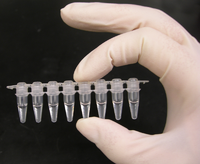
Photo from wikipedia
Stem trichomes and seed fibers originate from epidermal cells and partially share a regulatory pathway at the molecular level. In Gossypium barbadense, two insertions of a Ty1 long-terminal repeat-retrotransposon [transposable… Click to show full abstract
Stem trichomes and seed fibers originate from epidermal cells and partially share a regulatory pathway at the molecular level. In Gossypium barbadense, two insertions of a Ty1 long-terminal repeat-retrotransposon [transposable element TE1 and TE2] in a homeodomain-leucine zipper gene (HD1) result in glabrous stems. The primers used to identify the TE insertions in G. barbadense were applied to screen for the same events in 81 modern G. hirsutum varieties and 31 wild races. Three wild races were found carrying the same TEs as G. barbadense. However, the TE insertions in two of these wild races occurred at different sites (4th exon), therefore, named TE3, while the TE in the other wild race occurred at the same site as TE2. An RNA sequencing and qRT-PCR analysis indicated that the loss of HD1 function was caused by the TE insertion. Genetic mapping revealed a strong association between glabrous stems and TE3 insertions, confirming that HD1 is a critical gene for stem trichome initiation in G. hirsutum, as in G. barbadense. Using the long-terminal repeat sequence as a query to search against the Texas Marker-1 reference genome sequence, we found that the TE occurred after tetraploid cotton formation and evolved at different rates in G. hirsutum and G. barbadense. Interestingly, at least three independent insertion events of the same retrotransposon occurred preferentially in the A sub-genome’s HD1 gene, but not in the D sub-genome of G. hirsutum or G. barbadense, suggesting that an unknown TE insertion mechanism and resultant gene function changes may have hastened cotton speciation.
Journal Title: Molecular Genetics and Genomics
Year Published: 2019
Link to full text (if available)
Share on Social Media: Sign Up to like & get
recommendations!